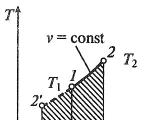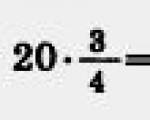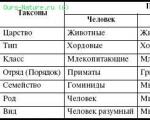How to change the fuel filter. We change the gasoline filter with our own hands
If you are an experienced car owner, then you have probably encountered such a problem as the need to replace the gasoline filter. This structural element of the car is responsible for screening out all debris, rust particles, dust, and also retains all dirt, preventing it from entering the fuel system line. At constituent parts the filter has an extremely small cross section, so the accumulated debris will sooner or later clog the filter, and, therefore, it will have to be replaced. You can do this with your own hands in the garage, without resorting to trips to car services.
Gasoline filter malfunctions
Fuel filtration in a car takes place in two stages: coarse cleaning, during which all more or less large particles are removed, after which fine cleaning takes place. We are talking about fine filters, which are located between the fuel tank and the engine.
The vast majority of automakers that manufacture products for modern market, claim that the fuel filter that is installed in their car is enough for the entire period of operation of the car. But such a result can be obtained only in laboratory conditions. In practice, the situation is quite different. The condition of the gasoline filter is greatly affected by the quality of the fuel, as well as the amount and structure of the debris that enters the system. You can neglect this type of repair, but what is it fraught with?
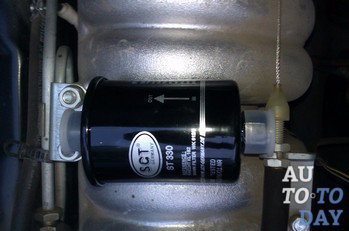 The consequences are really serious, since due to a clogged filter, the load on the filter increases, that is, its operating time is reduced. In addition, a clogged filter causes the engine to malfunction, as fuel is not supplied to the system as it should. That is, the car starts to triple, it can stall at any moment, or it may not start at all. There are also problems with gear shifting, since the automation in the automatic transmission incorrectly interprets the engine commands regarding gear shifting, therefore, it either does not change the gear at all, or does it at the wrong time.
The consequences are really serious, since due to a clogged filter, the load on the filter increases, that is, its operating time is reduced. In addition, a clogged filter causes the engine to malfunction, as fuel is not supplied to the system as it should. That is, the car starts to triple, it can stall at any moment, or it may not start at all. There are also problems with gear shifting, since the automation in the automatic transmission incorrectly interprets the engine commands regarding gear shifting, therefore, it either does not change the gear at all, or does it at the wrong time.
It makes sense to list clear signs, thanks to which you can determine exactly whether it is clogged fuel filter or not:
1) The engine of the car runs unevenly, that is, the car “troit”;
2) Periodically, while driving, there is a drop in the power of the car;
3) When moving at low speeds, the car stalls after pressing the pedal, even if you press it hard to the floor;
4) Speeds are switched incorrectly, that is, not on time;
5) Increased fuel consumption.
These are the symptoms of a disease called "clogged gasoline filter." But even if this does not happen to your car, then be prepared for the fact that one morning the car may not start. The problem is that these signs in the early stages of the “disease” are very difficult to notice, and therefore sudden troubles appear.
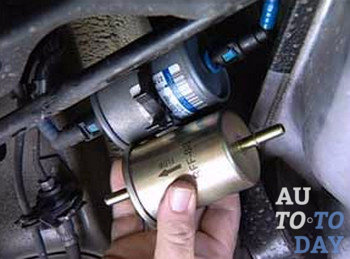 It should be dealt with one more question - what is the frequency of replacing the gasoline filter? The manual for your car will most likely indicate a figure of 40 thousand km. So, at least 10 thousand km must be subtracted from this figure, since both the roads in our country and the quality of the fuel supplied leave much to be desired. It turns out that a new gasoline filter must be installed after you drive a maximum of 30 - 35 thousand km by car. Specialists in services generally perform such a procedure after 20 - 25 thousand km, despite the manufacturer's recommendations.
It should be dealt with one more question - what is the frequency of replacing the gasoline filter? The manual for your car will most likely indicate a figure of 40 thousand km. So, at least 10 thousand km must be subtracted from this figure, since both the roads in our country and the quality of the fuel supplied leave much to be desired. It turns out that a new gasoline filter must be installed after you drive a maximum of 30 - 35 thousand km by car. Specialists in services generally perform such a procedure after 20 - 25 thousand km, despite the manufacturer's recommendations.
Petrol Filter Replacement Tools
In principle, replacing a gasoline filter is not a daunting task. It's all about patience and knowing the intricacies of this operation. First of all, you need to figure out what tools you need to prepare in order to make a replacement. If the filter is under the bottom of the car, then you will have to drive the car into an inspection hole. Before removing the element, you need to prepare the following materials:
1) A new gasoline filter, and you need to buy a product made by the manufacturer of your car, or one filter that, according to the recommendations of the same manufacturer, is suitable for your brand;
2) Spanners;
3) Phillips and slotted screwdrivers;
4) A piece of rag.
When buying a new gasoline filter, you need to check that the new element complies with the following parameters:
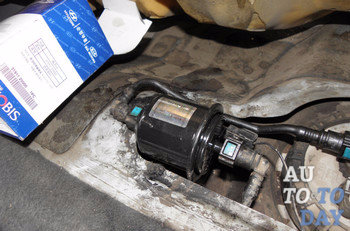 1)
Filtration level. If this indicator is not fulfilled enough, then large particles will still enter the system along with the fuel, and this is fraught with a quick engine breakdown;
1)
Filtration level. If this indicator is not fulfilled enough, then large particles will still enter the system along with the fuel, and this is fraught with a quick engine breakdown;
2) The area of the filtering surface, the presence of a rubber seal that will block the entrance directly to the filter. If there is no insulation, then in the future such a filter will be difficult to replace.
In general, fine filters, depending on the fuel system, are:
1) Carburetor. Their permissible degree of purification is 15-20 microns, that is, smaller particles will enter the system, but they will not cause serious harm to the motor;
2) Injection. The degree of purification is 5 - 10 microns. In such a system, the requirements for the maximum allowable particle size are higher. It turns out that the injectors can be clogged with larger particles, so the holes in the filters for them are made smaller.
Be sure to tell the consultant the brand of your car, as well as the year of its manufacture. This will help you choose the right filter. In principle, if there is no filter specifically for your car model, then you can find a suitable replacement.
Be sure to follow all safety regulations, as you have to work with combustible materials. During the process, gasoline may leak, so the room where you plan to work must be well ventilated. Before starting work, you must:
1) Disconnect the car by removing all terminals from the battery;
2) Do not smoke and do not carry out the procedure near sources of fire;
3) Prepare a fire extinguisher in advance (just in case);
4) If gasoline comes into contact with skin, immediately wash off the liquid with soapy water.
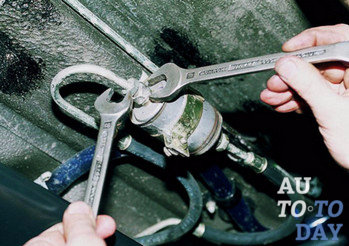 In addition, it is imperative to relieve the pressure in the gas line, since you have to work with the fuel system. In order to do this, you need to put the car on the handbrake and turn on the "neutral", after which you need to remove or move the rear seat, open the hatch, which is located under the seat on the bottom of the car, disconnect the connector to turn off the fuel line. After that, start the engine and wait until all the gasoline has come out of the engine. The car should shut down on its own. Try starting the car again to make sure the fuel pressure is gone.
In addition, it is imperative to relieve the pressure in the gas line, since you have to work with the fuel system. In order to do this, you need to put the car on the handbrake and turn on the "neutral", after which you need to remove or move the rear seat, open the hatch, which is located under the seat on the bottom of the car, disconnect the connector to turn off the fuel line. After that, start the engine and wait until all the gasoline has come out of the engine. The car should shut down on its own. Try starting the car again to make sure the fuel pressure is gone.
There is another way to relieve pressure. Remove the "negative" wire from the battery, then remove the F3 fuse located in the mounting block. This fuse is responsible for supplying power to the fuel pump. Start the engine to bleed all the fuel that is in it. After the pressure is released, you will need to return the fuse to its place.
Features of replacing a gasoline filter
The procedure for replacing the fuel filter can be complicated by the fact that the fuel system is in different machines constructed differently. There are brands in which the filter is located so conveniently that it can be replaced without using tools, but there are also machines in which the filter is literally hidden. This element can be fixed with special clips or spring clips, that is, improvised means in this case will not help at all. Before you get started, take a good look at how your car's fuel system is designed.
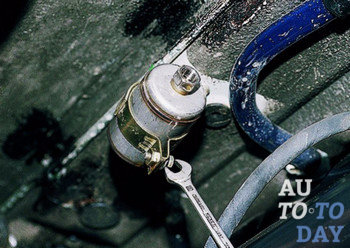 The instructions described below are somewhat universal, but differences in the process may be due to the characteristics of the fuel system. If the manufacturer installed the filter along with the fuel pump, then it would be better to replace the last element.
The instructions described below are somewhat universal, but differences in the process may be due to the characteristics of the fuel system. If the manufacturer installed the filter along with the fuel pump, then it would be better to replace the last element.
So, in order to remove the old fuel filter, you must:
1) Find out where the filter itself is located. If the car is carbureted, then the filter element is located under the hood or under the bottom, and in the case petrol car The filter will be in the tank with the fuel pump.
2) Regardless of where the filter is located, relieve pressure in the fuel system in advance (this was mentioned above).
3) Disconnect the machine by removing the "-" terminal of the battery.
Removing the fuel filter:
1) Carefully inspect the fuel filter and determine exactly how it is attached to the gas line (mounts can be exhaust or intake). The fasteners can be presented in the form of bolts or latches. It is very important to remember the sequence in which all the parts are located, so as not to get confused during installation. You can take a picture of the installation site, so that later it would be easier to restore the whole picture.
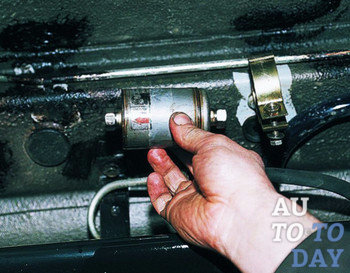 2)
Take a pre-prepared piece of rag and wrap it around the filter, as a small amount of gasoline will come out of it. Using a wrench or Phillips screwdriver, disconnect the fuel filter and fasteners. After that, the element can be removed.
2)
Take a pre-prepared piece of rag and wrap it around the filter, as a small amount of gasoline will come out of it. Using a wrench or Phillips screwdriver, disconnect the fuel filter and fasteners. After that, the element can be removed.
Installing a new filter:
1) Install the new filter in the position in which the old element was located (the arrow on the filter will help you, it shows the direction of gasoline movement).
2) Connect the gas line, do not forget to check the pipe for gusts before that. If it is damaged, then it will have to be replaced.
3) Reinstall the fuel pump fuse and reconnect the battery terminals.
4) Start the car. Most likely, the first attempt to do this will not work due to the deflated pressure in the fuel system. Leave the ignition on for 30 - 60 seconds, then try to start the engine again.
As you can see, even an inexperienced car owner can replace the fuel filter. Follow the instructions above and you'll be fine.
Subscribe to our feeds
Article from the category for general development, today we will talk about car filters, namely what they are, and how much do they cost in general? We will also touch on a couple of lines about their routine maintenance - that is, after how much to change? The article will be interesting for beginners who are just buying a car ...
As for the filters in the car, there are not so few, in total you can count 4 main types, namely:
- Engine air filter
- Cabin air filter
- Fuel filter element
- Oil
Some are probably wondering - why do we need filter elements in a car? YES, everyone is just guys, to put it mildly, our world is not perfect, there is dust and dirt all around, which can even penetrate into fuel and oil. It needs to be filtered out or simply removed, because it can cause damage to structures and reduce their resource. However, first I want to talk about the classification of filter elements.
Classification according to the degree of purification
From a scientific point of view (according to the properties of holding dust or dirt), these elements can be divided into three main types:
- "Absolute" filters. As it becomes clear, absolutely all dirt, soot, soot, etc. are captured from the name.
- Approximate to "absolute". Capture dirt as small as 1 µm.
- The third type, trap dirt from 10 microns.
It should be noted that almost all manufacturers use similar materials, therefore, the quality of the filters is very similar. Often, cheap and expensive brands are made from the same materials, and then there is marketing.
Fuel filters
Fuel is far from ideal, be it petrol or diesel. And in both, fuel oil, dirt, water, etc. can come across. This should not pass into the fuel system of the car, because it can clog the fuel passages, or damage the supply systems, in particular the injector. The filter can be placed in the tank - this is now often used in modern machines, as a rule, it is combined with a pump.
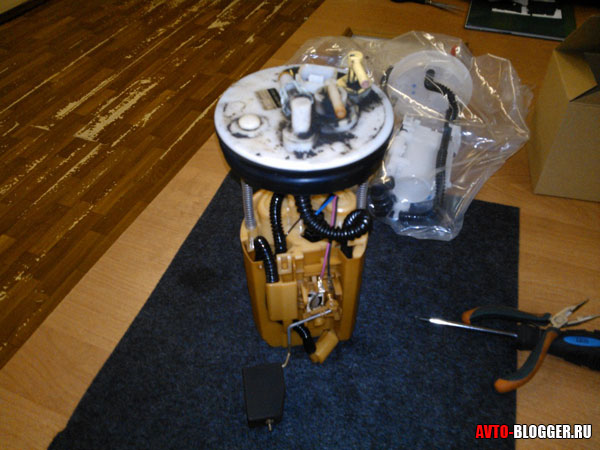
It also happens that it is taken out of bounds, such a design has met before, as instilled they stood in front of a mechanical pump.
Fuel filter elements are made from special papers that are impregnated with compounds resistant to gasoline or diesel (in particular, acrylic resin). Simply put, they shouldn't collapse.
They work for a long time, but they must be changed, because, after a certain mileage, a layer of dirt (or deposits) accumulates in them, which interferes with the fuel supply. Such filters are classified as "absolute", because the dirt can be quite fine.
Oil filter
It is installed, as a rule, on the engine block, on the side or from below. The main task is to clean engine oil from carbon deposits, dirt, chips, dust, etc. That is, the main task here is to clean the lubricant.
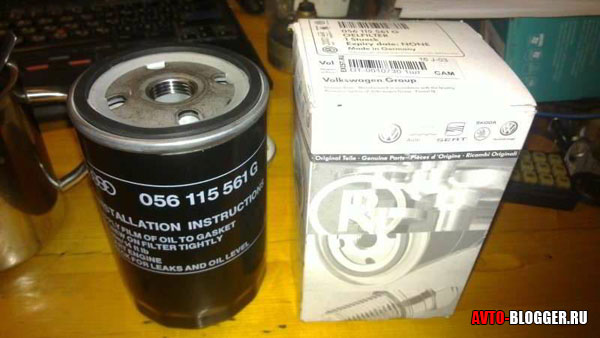
It consists of a housing, usually iron, and a filter part - also made of impregnated paper (similar to the gasoline version). Only here, passing ability at the level of 1 micron, if made too “dense”, then with cold oil it will simply break.
It should be noted that this element works under conditions of heavy loads, therefore, bypass valves are provided on it - in winter when low temperatures, it simply does not work until the oil is heated to operating temperature, and dumps grease into this valve. Although variants are now beginning to appear, they are made differently.
Since it works with engine oil, and it is located near hot pistons, it loses its ability after 10 - 15,000 km, so it IS MANDATORY TO CHANGE with every oil change.
Air for engine
These elements work in air intake systems needed to create an air-fuel mixture. If there were no filter, then all the dust and dirt that settles on it penetrated the engine cylinders, and this is sand, dirt, dust, and even water. All this will negatively affect the engine resource, because sand from high temperatures will simply melt and turn into glass, if it settles on the rings or piston walls, then the resource will decrease significantly! The filter, despite its simplicity and device, does not allow this to happen. Its function is difficult to overestimate.
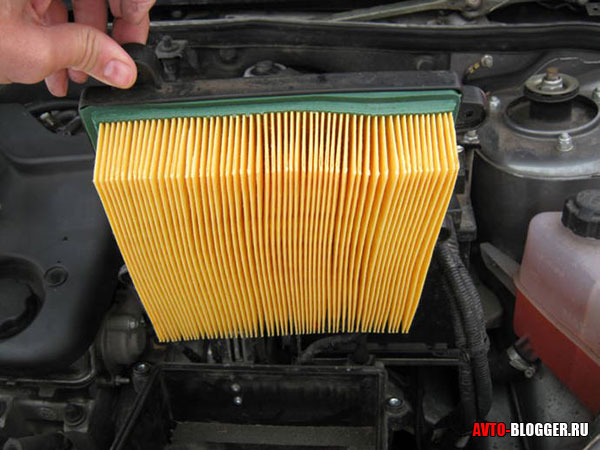
What I want to note is that when replacing, you must definitely check whether it fits snugly to its “nest”, even small cracks are not possible, because unwanted “garbage” can flow through them.
It is also worth noting that - air elements change much more often than, say, fuel ones, preferably with each oil change.
According to the classification, they are in second place, that is, they do not let through particles less than - 1 micron, this is quite enough.
Air for salon
Perhaps this is the most minor filter element for the car as a whole, but the most important filter element for your comfort and health. It is installed in front of the air intake from the street and does not allow dust and dirt to enter the cabin. What a very necessary device, because it does not allow the stove radiator and air conditioner to clog.
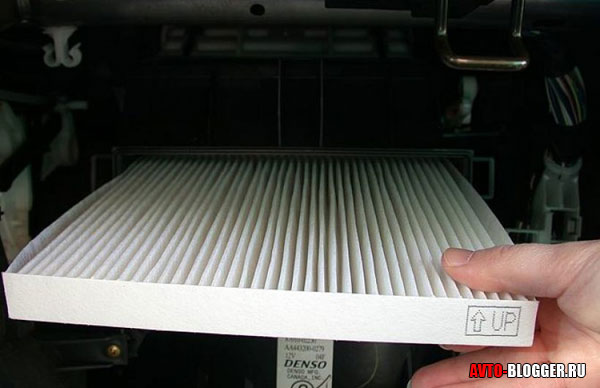
What I want to say is that now there are two varieties, it is ordinary and coal. Coal also removes odors (for example, KAMAZ smokes in front), but it has a big minus in wet weather, it does not work well, because the coal component simply swells, preventing the air flow from moving, simply - windows start to sweat much more.
These elements are made according to the third pass class, that is, 10 microns.
In conclusion, I would like to give a couple of tips on replacing each of the subspecies:
- Fuel - if it is in the tank, it changes every 70 - 80,000 kilometers, it just clogs up.
- Oil - changes with each oil change, STRONGLY NOT RECOMMENDED to fill in clean oil with a dirty filter. Interval 10 - 15,000 kilometers
- Air - changes through MOT (maximum after two), that is - 30 - 45,000 kilometers.
- Salon - I personally would change every MOT, that is, 15,000 kilometers, because you breathe dust.
Today I have everything, I think the article was useful to you. Read our AUTOBLOG.
The filter element is a consumable item and requires periodic replacement. Many motorists forget about this and face the unpleasant consequences (symptoms) of a clogged fuel filter. For example, when overtaking a truck, the driver presses the gas pedal, and the car picks up speed very slowly.
The condition of the new and old filter elements (new on the left).
The main task of the fuel filtering device is to clean the fuel from harmful impurities: dust particles, dirt, insects, plants, resins, and condensate. The presence of water in the fuel system leads to rusting of the injectors, contributes to the development of corrosion, which is very detrimental to ensure the normal operation of the engine, these harmful impurities can clog the fuel system. The specified device allows you to clean low-quality fuel from resin particles and various additives added to the fuel by unscrupulous manufacturers.
Depending on the technological features and type of injection, various fuel filters are distinguished:
- For carburetor cars, it is necessary to clean the fuel from dirt particles up to 20 microns.
- On machines equipped with an injector, the degree of purification is up to 5 microns. Particles smaller than the specified size will penetrate the injection system, but cannot cause significant harm.
- Diesel power units use special fuel filter elements that can not only remove dirt particles smaller than 4 microns, but also prevent small drops of water from entering the injection system.
Possible malfunctions
The symptoms of a clogged fuel filter are quite varied. Keep in mind that the symptoms listed below may indicate not only a breakdown of the filter device, but also possibly indicate the causes of a malfunction in the control system. To make sure for reinsurance that the reason is in the fuel filter, you can use the following method: take a pressure gauge and connect it to the nipple located on the fuel injector frame, then start the car, measure the pressure of the fuel mixture. In the case when the pressure gauge shows parameters below those provided by the car dealer, we can talk about a fuel filter malfunction.
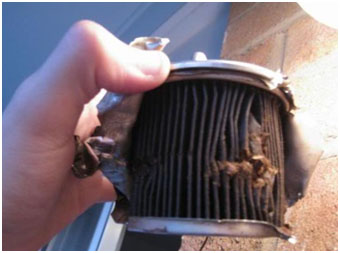 clogged filter
clogged filter When decreasing bandwidth the filtering device is experiencing interruptions in operation power unit:
- fuel consumption increases;
- the car is stalling idling;
- there are failures in the operation of the motor with an increase in speed;
- it is difficult, and sometimes impossible, to start the engine;
- the power of the power unit decreases, it starts to triple;
- it is possible to brake the car while driving without pressing the “brake” pedal;
- when driving up an incline, the vehicle twitches.
All these signs are observed if the filter is clogged, its increased resistance to the intake air flow creates an additional load on the engine.
Causes of clogged filter element
We figured out the signs of a clogged fuel filter, now let's see the reasons leading to clogging of the filter device:
- Refueling the car with fuel of dubious quality. If the car is often refueled at small gas stations (which have not proven themselves in the car market), keep in mind: the sale of gasoline and diesel fuel is good business, therefore, in order to reduce the cost of production, increase turnover, the owners of gas stations add various additives and resins that can clog not only the filter, but the entire system.
- Insufficient fuel cleaning. After the production of a combustible mixture, it is transported, therefore, from canisters, tanks, reservoirs, paint particles, dirt, and harmful impurities may enter the specified liquid.
- Dusty air. It's no secret that our cars are operated in far from ideal operating conditions, the presence of dust particles, dirt, insect particles, plants in the air is inevitable.
It is impossible to eliminate these causes, so keep an eye on the condition of the filtering device, follow the dealer's recommendations regarding the scheduled replacement of consumables. Self-replacement filter device, if the machine is not under dealer warranty.
Purpose and features of the fuel fine filter
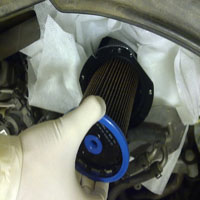 How often should the fuel filter be changed? diesel car?
How often should the fuel filter be changed? diesel car?
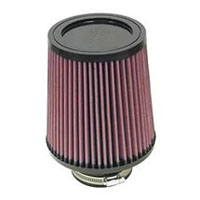 The expediency of installing filters of zero resistance
The expediency of installing filters of zero resistance
Imagine that you are driving on a highway, when suddenly a large truck pulls onto the road. You step on the gas to give room to the truck, but then you feel the car start to rumble. You return home and happily forget about it. A month later, the car stalls at a traffic light. You still manage to start it and somehow get home, but this time you are already wondering what happened.
Such a malfunction can occur for many reasons, but most likely a clogged fuel filter is to blame. If the fuel filter is clogged, the car may not start at all. While manufacturers claim that a fuel filter should last the life of a vehicle, many auto mechanics recommend changing it every 12,000 miles (19,312 km) [source: Chaikin].
Fuel filter located between the fuel tank and the fuel pump. The fuel pump delivers fuel to the engine, the fuel filter traps all third-party impurities that can clog the nozzles and prevent the car from working properly.
If you are trying to save money in the current hard times, then, most likely, you yourself perform minor repairs that you would have previously entrusted to professionals. So, how difficult is it to change the fuel filter on a scale from "insert the cigarette lighter" to "sort out the engine"? The answer to this question depends on what kind of car you have. With some cars, everything is simple, but in others, the filter can be part of more complex systems, and its replacement requires experience and knowledge. Car Care Council, non-profit organization, which helps drivers take proper care of their cars, advises having the filter replaced by a professional if it's in a hard-to-reach place [source: Car Care Council].
Fuel filter replacement tools
Changing a fuel filter usually requires simple tools such as a wrench, socket wrench, screwdriver and pliers. In addition, you may need other tools depending on how the filter is installed on the fuel line. For example, if the filter has a threaded connection, then you will need an open end wrench or ratchet and socket wrench. If the filter is mounted on snaps, then pliers will be enough for you. A flashlight may also come in handy, especially if the filter is installed in a hard-to-reach place.
Depending on the brand of car, you may need special tools to remove the fuel filter. For example, on some GM, Ford, and Mazda models, the fuel filter has a spring retainer that requires a special tool to remove. We also recommend that you read the maintenance manual or find information on the Internet to prepare necessary tools. Finally, have your cleaning supplies ready ahead of time so you can clean up when you're done.
Oh, and most importantly, don't forget to buy a new fuel filter. Fuel filters are produced various companies, and you can easily buy it at the nearest parts store. Ask a sales assistant to help you choose the appropriate filter, for this you need to know the year of manufacture and model, otherwise the filter may not be suitable.
The most common fuel filter manufacturers are ACDelco, Fram and Motorcraft. The cost of a new fuel filter ranges from $5 to $50. Most filters cost no more than $15, which is clearly cheaper than replacing a fuel pump in the middle of the road. Unfortunately, not all vehicles use replaceable fuel filters. In some models, filters are built into the fuel tank, fuel pump or other components, and if it is time to change the filter, then the entire assembly must be replaced.
Preparing the vehicle for fuel filter replacement
Regardless of the complexity of the work ahead, you must always think about safety first. Even if you do everything carefully, when you change the filter, flammable gases are released and a small amount of fuel spills out. For this reason, repairs should be carried out in a well-ventilated area and any drops of fuel should be wiped off immediately. It is best to change the filter on the street, because. Fuel vapors are heavier than air and can accumulate in an enclosed area, which can cause a fire.
In addition, goggles and disposable nitrile gloves must be worn to prevent gasoline from getting into the eyes through the skin of the hands. Nitrile gloves are more expensive than latex gloves, but offer better protection against soaking up solvents such as gasoline and are ideal for this job. Of course, it is not recommended to smoke and work near an open flame, such as a burner, when working on components of the vehicle's fuel system. Just in case, you should take care of the presence of a fire extinguisher.
Depending on the location of your vehicle's fuel filter, a jack may also be needed. In this case, apply the handbrake to the vehicle and place blocks under the wheels to ensure contact with the floor surface. When working under a car, the last thing you want is for it to go suddenly. We recommend that you refer to your vehicle's service manual for the safest location for the jack. After lifting the machine to the desired height, it is necessary to use supports instead of a jack. Otherwise, there is a risk of the vehicle falling while working under it. After installing the supports, the car will be ready for service. Next, we will describe in detail how to properly change the fuel filter.
Removing the old fuel filter
The fuel filter may be located near the fuel tank or closer to the engine.
Usually, the filter on the fuel line has two fasteners - from the intake side and from the exhaust side, the whole assembly is fixed with a bracket. The fuel filter in your car can be installed on any part of the fuel line, i.e. both at the fuel tank and under the hood.
After you find the filter, you need to release the pressure in the fuel line; otherwise, the fuel will spill all over the place, creating a fire hazard and a mess in the workplace. There are several ways to relieve pressure, but the easiest is to pull the fuel pump fuse and wait for the engine to stall.
After that, you need to disconnect the negative terminal of the battery in order to avoid accidental ignition of fuel vapors. Then inspect the fuel filter to determine how it is attached to the fuel line. In some cases, the filter is attached with latches. It is also possible to fasten it with wing bolts or other fasteners. Make sure you remember where the washers and o-rings were installed. Despite the fact that all the necessary fasteners are included with the new fuel filter, you need to install them correctly.
Before starting the dismantling of the fuel line, the filter must be wrapped with rags to prevent fuel from escaping. After disconnecting the fuel line, remove the fuel filter by removing it from the bracket.
Installing a new fuel filter
Now everything is ready to install a new fuel filter. Most filters have a pointer in the form of an arrow to determine right direction installation, so make sure you don't put the filter backwards. In some cars, the filter will not fit if it is incorrectly located, which eliminates the possibility of error. On other vehicles, you will need to trace the fuel line to determine which tube goes to the engine and which goes to the fuel tank. But it will be much easier to pay attention to how the old filter was installed and install the new one in the same way.
After attaching the filter to the bracket, connect the fuel line using the new fasteners that came with the filter. If you choose to use the old latches, be aware that over time they can loosen and not secure the filter to the fuel line properly.
Speaking of the fuel line, do not forget to check the integrity of the lines, if there are cracks, they must be replaced. After installing a new fuel filter, simply insert the fuel pump fuse, connect the negative battery terminal and start the engine. The car does not always start the first time, so do not be afraid. When the filter was changed, the pressure in the fuel line was released, so it may take several attempts to start the engine before the pressure is built up and the car starts.
After that, check for leaks, wipe up any spilled fuel, and praise yourself for successfully servicing your vehicle's fuel system.
Read our other articles for car care tips.
If the car engine began to work unstably (stall, triple, start poorly), then there may be several reasons for this, one of them is a failed fuel filter. However, to make sure that this particular unit is out of order, it is necessary to reliably determine the cause of the unstable operation of the engine. If the cause of the breakdown is in this part, then the fuel filter should be replaced with a new unit, taking into account the features of different filter models. You can do this in a car service, or on your own. How to choose and replace the fuel filter yourself, we will consider below (see the video "Replacing the fuel filter on a VAZ 2110, 2111, 2112" below).
When should the fuel filter be changed?
Automotive experts advise replacing fuel filters after 60,000 km, since that is when they are sufficiently clogged. The car, of course, will be able to drive for a long time even on a clogged filter, however, in this case, the load on the fuel pump increases, the service life of which begins to decrease. In addition, the engine will begin to malfunction due to incorrect fuel supply. To reliably establish that it is the fuel filter that has broken (clogged), you must do the following:
- Accelerate the car at low speed;
- Press as sharply as possible on the "gas".
In the event that the car engine starts to work jerkily or refuses to accelerate, then the reason for the unstable operation of the power unit is precisely in the filter, that is, replacing the fuel filter is inevitable.
How to choose the right fuel filter for your car?
KEY PARAMETERS. The choice of a fuel filter should be made taking into account the following key parameters:
- Consider the value of the filtration level: it determines which, in size, particles should be filtered out. If you choose a filter with a low level of filtration, then large particles will penetrate into the fuel and, in the very near future, will disable the engine.
- Take into account the area of the filtration element, the clogging rate will depend on it: the larger the area, the longer the filter will last, and vice versa;
- The presence or absence of a rubber seal covering the filter inlet: filters without a seal are more difficult to change.
CLEANING LEVEL. It is also necessary to distinguish between fuel filters according to the level of cleaning so that the replacement of the element is carried out correctly. So, there are carburetor, injection and diesel fuel filters. Each type of engine has a corresponding fuel filter.
- For carburetor systems, the cleaning level is in the range of 15 to 20 microns. Anything smaller will enter the fuel system, however, it will not pose any harm to the engine;
- For injector systems, the cleaning level is in the range of 5 to 10 microns.
- For diesel systems, the cleaning level is in the range of less than 5 microns. In this case, not only particles in the fuel are filtered, but also water.
Of course, when buying a new car fuel filter, you need to know the brand of the old filter, as well as when it was produced. As for replacing the filter with a similar one, but of a different brand, here you need to carefully study the possibility of this operation in the car's operating manual.
How to change the fuel filter yourself?
Before starting work, it is necessary to relieve pressure in the fuel system.
The direct replacement of the fuel filter on a car begins with determining its location. The most common variant of its location is under the hood, on top of the engine (almost all diesel engines).
For gasoline engines, the fuel filter is located in close proximity to the fuel pump.
1. You need to start the engine of the car.
2. Immediately after the filter is found, its fuse should be dismantled and wait until the engine stalls on its own so that the pressure drops and the fuel does not start to pour out.
3. Then remove the battery terminal with the “-” sign (to prevent fire).
4. After that, disassemble the diagram of how the dismantled filter is installed in the fuel line system. Remember the sequence of location of each of the fasteners, as well as washers and gaskets.
5. After removing the unit from the bracket, and wrapping it with a rag, you need to carefully pull it out (the wrapped rag will absorb oil if it leaks).
7. Using new fasteners, connect the filter to the fuel line system.
8. On this, the replacement of the fuel filter with a new element is completed. It remains only to put the fuse, taken out at the very beginning of work, in its original place.
9. Reconnect the negative terminal and start the engine.
Note that an attempt to start the engine the first time usually fails, since the pressure released during dismantling must be restored.
Video: Replacing the fuel filter on a VAZ 2110, 2111, 2112
If the video is not showing, refresh the page or

